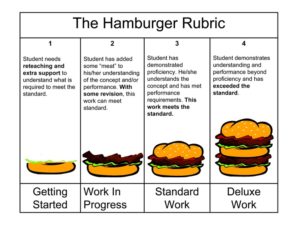Introduction to Rubrics
Students, especially in online courses, want specific feedback on their assignments to understand why they received the grade assigned by an instructor and how they could improve.
There are a few different formats for communicating your expectations (e.g. articulating in detail as part of assignment instructions), but rubrics have become increasingly common in higher education. Rubrics provide clear criteria regarding what is expected for an assignment and guide specific feedback on why a certain grade has been given. Rubrics may also make it more efficient for instructors to provide specific and detailed feedback.
“Every time I introduce rubrics to a group of teachers the reaction is the same: instant appeal (“Yes, this is what I need!”), followed closely by panic (“Good grief, how can I be expected to develop a rubric for everything?”). When you learn what rubrics do — and why — you can create and use them to support and assess student learning without losing your sanity.” — Author Heidi Goodrich Andrade in her article Understanding Rubrics.
What is a Rubric?

Rubrics provide clear criteria regarding what is expected for an assignment and guide specific feedback on why a certain grade has been given. Rubrics may also make it more efficient for faculty members to provide specific and detailed feedback.
Consider rubrics for activities that make up a significant portion of the grade so that students understand what is expected, how they will be assessed, and how to improve. A rubric is a detailed articulation of the criteria against which student work will be judged.
Rubrics…
-
- List categories of performance to be assessed.
- Describe levels of performance in each category.
- Communicate criteria for developing, revising, and judging work.
- Make criteria transparent for purposes of effective feedback and/or grading.
